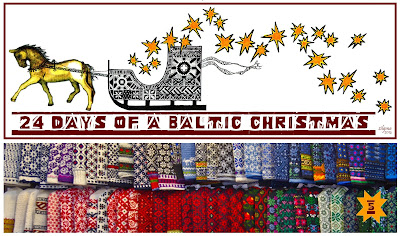Priecīgus
Ziemassvētkus! Linksmų Kalėdų! Häid jõule! May your holidays be warm and
bright, and may the New Year bring health and happiness!!!
I’m forever
grateful to everyone who has contributed to this series: in the form of posts,
photographs, illustrations, interviews and ideas. As to the readers, the
friends who commented and translated, and those who put me in contact with
bloggers and authors all over the world, a heartfelt thank you as the series
would not have been a success without you. Special mention to my husband for
all of his assistance in editing (his specialty is answering the question “I
know it’s late, but can you read this and suggest a title?”), artist ZILGMA for
the uniquely Baltic logo (she’s also my ‘phone-a-friend’ for culinary
questions!) and to Lauris, Mikus and Vilis for their patience with me while working on the enormous labor of love that is 24 Days of a Baltic Christmas.
On
this final day of the series, a review of all the wonderful
contributions we’ve seen this month. We kicked off 24 Days of a Baltic
Christmas with a giveaway, and two lucky readers received a Baltic Christmas
magnet to help make their fridge a little more festive! Then Day 2
brought a look at all the Estonian, Latvian and Lithuanian Christmas markets
taking place across the US, Canada, Australia and Europe.
On Day
3 we welcomed Ilze Kļaviņa with her recipe for cūkas šnukurs! The Minneapolis saimniece
supplied us with a recipe and all sorts of tips in incorporating this traditional
Latvian holiday food in our Ziemassvētku feast. ImantaDimanta dropped an
exclusive Christmas track on Day 4 of 24 Days of a Baltic Christmas, and the
tour dates of the upcoming US Centennial Tour were revealed including stops on
the West Coast, East Coast and everywhere in between!
Elizaberth
Georgian of the blog In Search Of joined us on Day 5 with gift ideas from all
three of the Baltic countries. Then on Day 6 Lelde of Life in Riga gave us a
tour of the Jamarka art market at the Art Academy of Latvia.
Barbara
Tedrow’s article Kučios, The Longest Night appeared on the 7th day of 24 Days
of a Baltic Christmas, tracing the Lithuanian family Christmas tradition from
her childhood through modern day. Then we hopped across the ocean on Day 8 with
author Emily Gilbert, for a look at Baltic Christmas traditions in the U.K.
Day 9
was a discussion of the role of animals in the magical events of the winter
solstice: when animals speak on Christmas Eve, and a bountiful harvest, marriage,
riches & health can be forecast by watching animals and nature during the
weeks around Christmas. Then we gained insight into the journey of the Peace
Light from Bethlehem to Europe and across the United States & Canada on Day 10, the tradition bringing light and peace to Scouts and their families across the world.
Andrejs,
a new addition to the Minneapolis Baltic culinary scene, provided us with a
Beginner’s Guide to Galerts on Day 11, turning this gastronomic holiday mystery
into a realistic addition to any holiday table. Then on Day 12 we welcomed
Rachel from Baltic Stitches to the series, with a post on an alternative to
Latvian Mitten Mania - mini lapel mittens.
Learn
how to make kanēļmaizītes with Ilze Ieviņa from the blog Let the Journey Begin
on Day 13! Then on Day 14 read about the serious problem of the looting of
Latvian archaeological sites in Balticsmith’s article Museum-Quality Viking Artifact or Destroyed Ancient Latvian Burial?, (hopefully) the first in a
series of a more in-depth look at this plague threatening our culture and
heritage.
On Day
15 we welcomed Kristīna with her article on her choral Christmas tradition and the New York Latvian Concert Choir's annual Christmas concert. Then we
traveled to Vilnius on Day 16 for a cup of coffee with Coffee1 on the day their
interactive self-service hot chocolate station opened at their Uzupis location.
Photographer
Ilze Lucero shared her childhood memories of puzuri with the Day 17 post, and
shared her project Portrait of a Latvian Nomad, an ongoing undertaking in honor
of LV100. On Day 18 I was honored to present the Latvian web series Lodziņš uz Latviju (“A Little Window to Latvia”) with their December episode featuring kanēļmaizītes,
a walk through the streets of Vecrīga all decked out for the holidays, and a Christmas
tune from ImantaDimanta!
On the
final week of 24 Days of a Baltic Christmas we took a closer look at the
Lithuanian holiday traditions involving hemp and poppy seeds with Viktorija and
her post High on Christmas on Day 19. Latvian mittens made another appearance
on the series the following day as Māra Linde introduced readers to the Latvian Mittens Traveling Exhibit, currently making its way around the United States as
part of LV100 celebrations.

My
sister Zinta gave us a glimpse of the Seattle Christmas market on Day 21 with a
video featuring interviews with shoppers and vendors, as well as an appearance
by the folk dance troop Trejdeksnītis. Day 22 brought the exciting news that Toronto, ON will host the XV Latvian Song Festival in July 2014. Then on Day 23, Karl Altau presented an
interview with Jõuluvana himself during one of his appearance at the Baltic
Christmas celebrations in Rockville. I want to know what kind of pull Karl has,
that he managed to bring such an in-demand guest to the series this close to
the holidays; maybe he can put in a good word to Ziemassvētku vecītis for my
boys, they’ve been really well-behaved!
I hope you enjoyed this fourth year of counting down the days to a Baltic Christmas! We’re so thankful to have been part of your holiday preparations this month, and hope you found some Christmas spirit here on Femme au Foyer. I wish you and yours a very merry Christmas and a fantastic New Year.
Until next year,
Liene













































